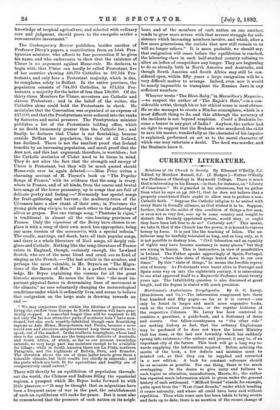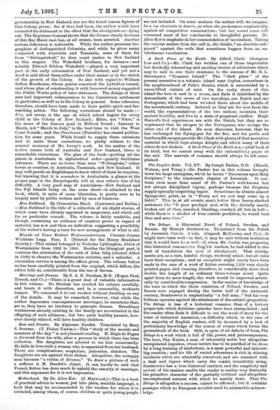Hutchinson's Australasian Encyclopedia. By G. C. Levey. (Hutchinson and Co.)—The
information compressed into these four hundred and fifty pages—so far as it is correct— can only be found in larger and much more expensive books, such as the various year-books, or the regular histories of the respective Colonies. Mr. Levey has here contrived to combine a gazetteer, a guide-book, and a dictionary of dates and events. Our fellow-countrymen on "the other side" are making history so fast, that the ordinary Englishman may be pardoned if he does not know the latest Ministry that has risen, or the last new township which has suddenly sprung into existence,—the embryo and pioneer, it may be, of an important city of the future. This book will go a long way to- wards supplying the information required. Before noticing the merits of the book, a few defects and mistakes must be pointed out, so that they can be supplied and corrected in a new edition. A book for constant reference should be as accurate as possible. For one thing, there is too much overlapping. In the desire to give unity and fullness to such topics as education, manufactures, Maoris, &G., the author has repeated much information which is given under the general history of each settlement. "Milford Sound" stands, for example, quite apart from the "West Coast Sounds," under which heading it comes naturally, and where all could have been said without repetition. Then while some care has been taken to bring events and facts up to date, there is no mention of the recent change of
governorship in New Zealand, nor are the latest census figures of that Colony given ; for if they had been, the author would have corrected his statement to the effect that the aboriginals are dying out. The Registrar-General shows that the former steady decrease of this fine Maori race has, at all events, been arrested. Another serious deficiency is noticeable. While the author promises bio- graphies of distinguished Colonists, and while he gives many connected with Australia and Tasmania, some of them far from "distinguished," he does scant justice to New Zealand in this respect. The Wakefield brothers, for instance—and notably Edward Gibbon Wakefield—played a very important part in the early colonisation of New Zealand, and yet not a word is said about them either under their names or in the sketch of the growth of the Colony. So also with regard to William Sefton Moorhouse, whose genius conceived the Lyttelton tunnel, and whose plan of constructing it with borrowed money suggested the Public Works policy of later statesmen. The doings of these men had important consequences to the Canterbury settlement in particular, as well as to the Colony in general. Some reference,
therefore, should have been made to their public spirit and far- reaching action. The following corrections should be made :— Five, not seven, is the age at which school begins for every
child in the Colony of New Zealand ; Mitre, not "Nitre," is the name of the famous peak in Milford Sound ; January to March, not "March to July," is the best time to visit the West Coast Sounds ; and the Churchman (Dunedin) has ceased publica- tion for some years. While bound to supply these omissions and to make these corrections, we gladly witness to the general accuracy of Mr. Levers work. In the matter of the native names both of Australia and New Zealand, there is remarkable correctness. The plan of the book—putting all the places in Australasia in alphabetical order—greatly facilitates reference. There are no fewer than nine "Wellingtons," either towns or counties, in Australia, Tasmania, and New Zealand. It may well puzzle an Englishman to know which of these he requires; but knowing that it is somewhere in Australasia, a glance at the proper page in the Encycloptedia will at once relieve him of his difficulty. A very good map of Australasia—New Zealand and the Fiji Islands being on the same sheet—is attached to the book, which, in spite of some blemishes, is pretty sure to be largely used by public writers and by men of business.











































 Previous page
Previous page